Nursing Assessment: Clean Wound Dressing Techniques in Surgery
VerifiedAdded on 2023/03/21
|9
|1890
|92
Report
AI Summary
This report investigates the use of clean wound dressing techniques as a safe alternative to sterile techniques in surgical wound care. The study reviews various articles and experiments, highlighting the benefits and drawbacks of both approaches. The findings suggest that clean dressing techniques, when performed with proper hand hygiene and a clean environment, can be a safe and cost-effective option for many patients, especially in long-term and home care settings. While sterile techniques are considered more effective, the report emphasizes that clean dressing techniques can reduce the risk of infection and promote healing, making it a viable option for nurses in various healthcare settings. The report concludes that clean helical dressing is considered as a safe option for the dressing of various surgical injuries.
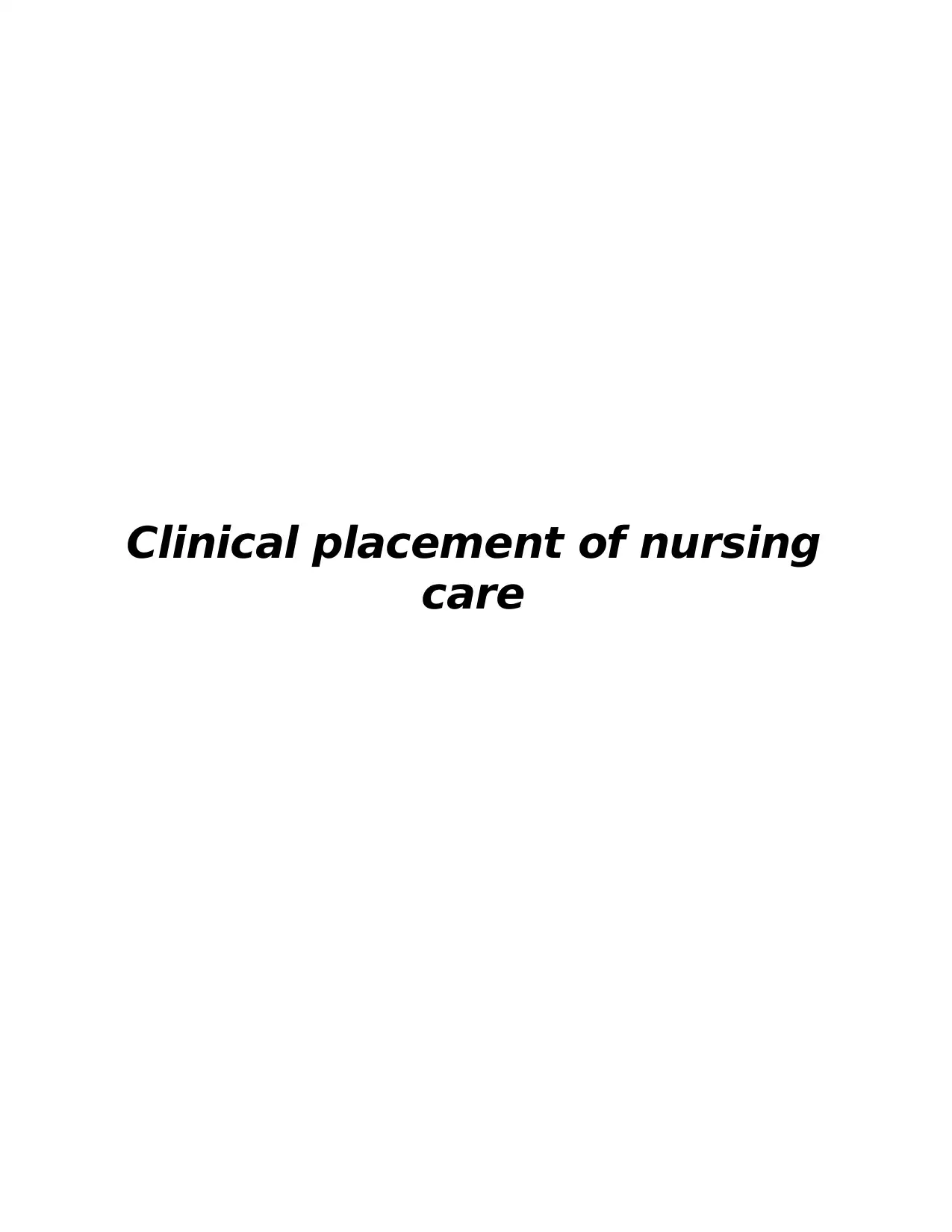
Clinical placement of nursing
care
care
Paraphrase This Document
Need a fresh take? Get an instant paraphrase of this document with our AI Paraphraser
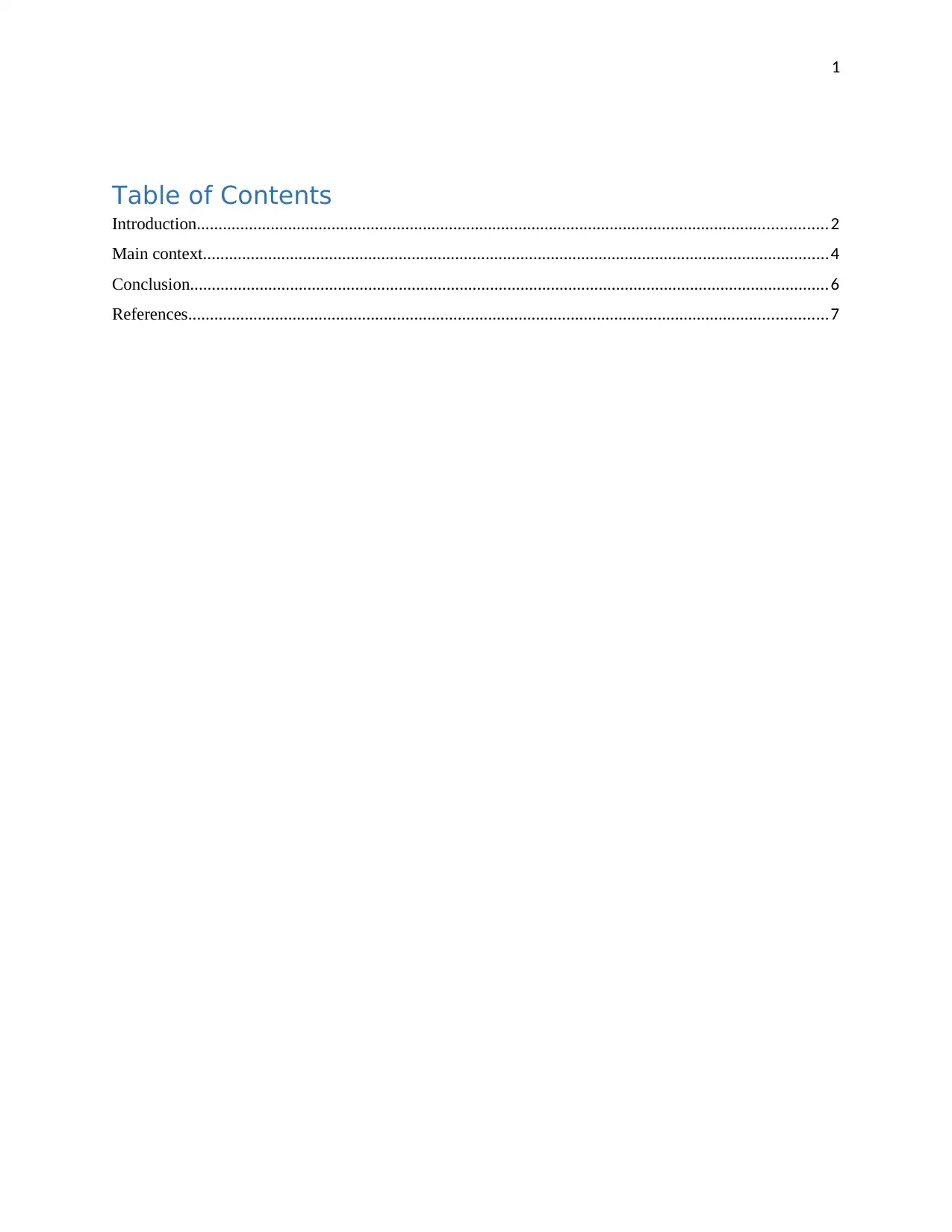
1
Table of Contents
Introduction.................................................................................................................................................2
Main context................................................................................................................................................4
Conclusion...................................................................................................................................................6
References...................................................................................................................................................7
Table of Contents
Introduction.................................................................................................................................................2
Main context................................................................................................................................................4
Conclusion...................................................................................................................................................6
References...................................................................................................................................................7
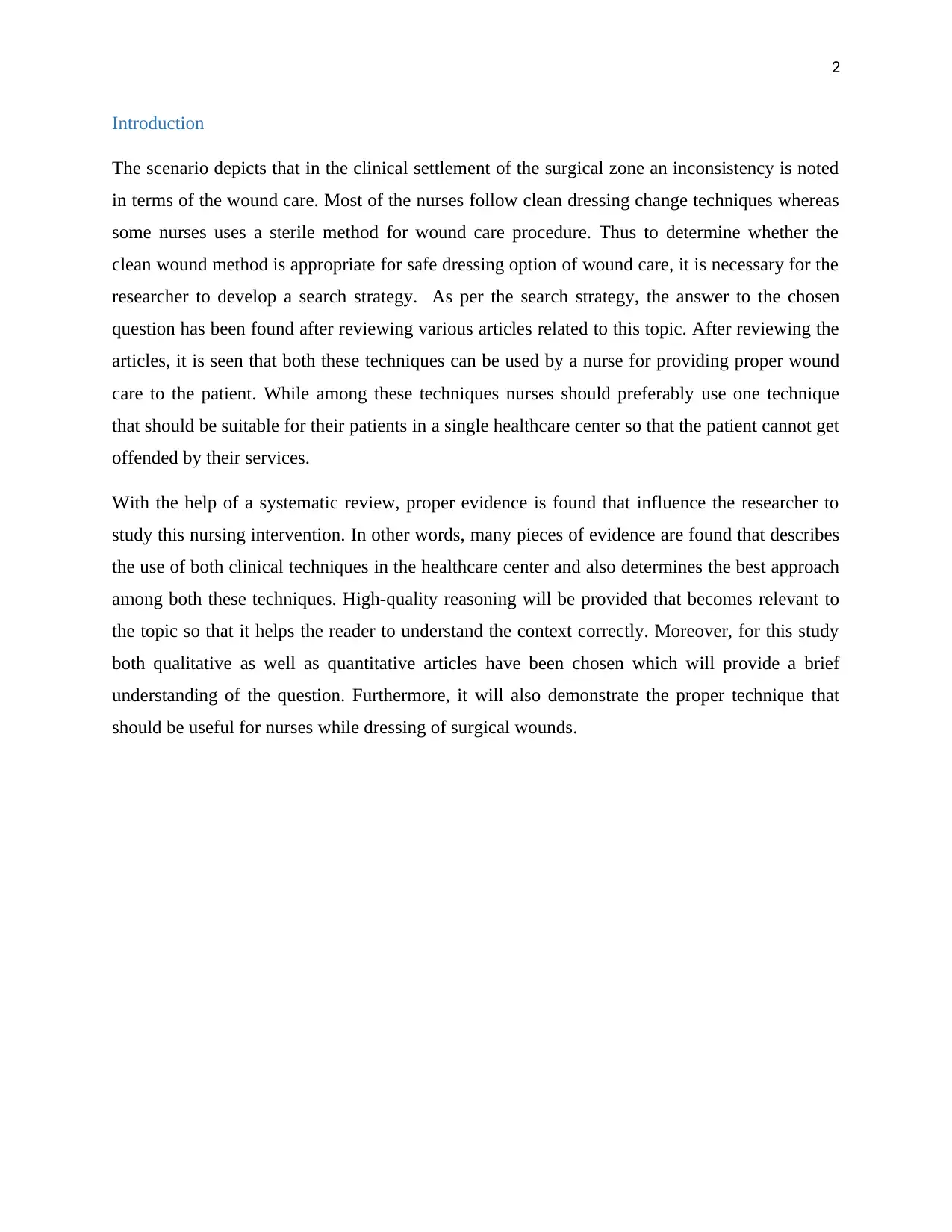
2
Introduction
The scenario depicts that in the clinical settlement of the surgical zone an inconsistency is noted
in terms of the wound care. Most of the nurses follow clean dressing change techniques whereas
some nurses uses a sterile method for wound care procedure. Thus to determine whether the
clean wound method is appropriate for safe dressing option of wound care, it is necessary for the
researcher to develop a search strategy. As per the search strategy, the answer to the chosen
question has been found after reviewing various articles related to this topic. After reviewing the
articles, it is seen that both these techniques can be used by a nurse for providing proper wound
care to the patient. While among these techniques nurses should preferably use one technique
that should be suitable for their patients in a single healthcare center so that the patient cannot get
offended by their services.
With the help of a systematic review, proper evidence is found that influence the researcher to
study this nursing intervention. In other words, many pieces of evidence are found that describes
the use of both clinical techniques in the healthcare center and also determines the best approach
among both these techniques. High-quality reasoning will be provided that becomes relevant to
the topic so that it helps the reader to understand the context correctly. Moreover, for this study
both qualitative as well as quantitative articles have been chosen which will provide a brief
understanding of the question. Furthermore, it will also demonstrate the proper technique that
should be useful for nurses while dressing of surgical wounds.
Introduction
The scenario depicts that in the clinical settlement of the surgical zone an inconsistency is noted
in terms of the wound care. Most of the nurses follow clean dressing change techniques whereas
some nurses uses a sterile method for wound care procedure. Thus to determine whether the
clean wound method is appropriate for safe dressing option of wound care, it is necessary for the
researcher to develop a search strategy. As per the search strategy, the answer to the chosen
question has been found after reviewing various articles related to this topic. After reviewing the
articles, it is seen that both these techniques can be used by a nurse for providing proper wound
care to the patient. While among these techniques nurses should preferably use one technique
that should be suitable for their patients in a single healthcare center so that the patient cannot get
offended by their services.
With the help of a systematic review, proper evidence is found that influence the researcher to
study this nursing intervention. In other words, many pieces of evidence are found that describes
the use of both clinical techniques in the healthcare center and also determines the best approach
among both these techniques. High-quality reasoning will be provided that becomes relevant to
the topic so that it helps the reader to understand the context correctly. Moreover, for this study
both qualitative as well as quantitative articles have been chosen which will provide a brief
understanding of the question. Furthermore, it will also demonstrate the proper technique that
should be useful for nurses while dressing of surgical wounds.
⊘ This is a preview!⊘
Do you want full access?
Subscribe today to unlock all pages.

Trusted by 1+ million students worldwide
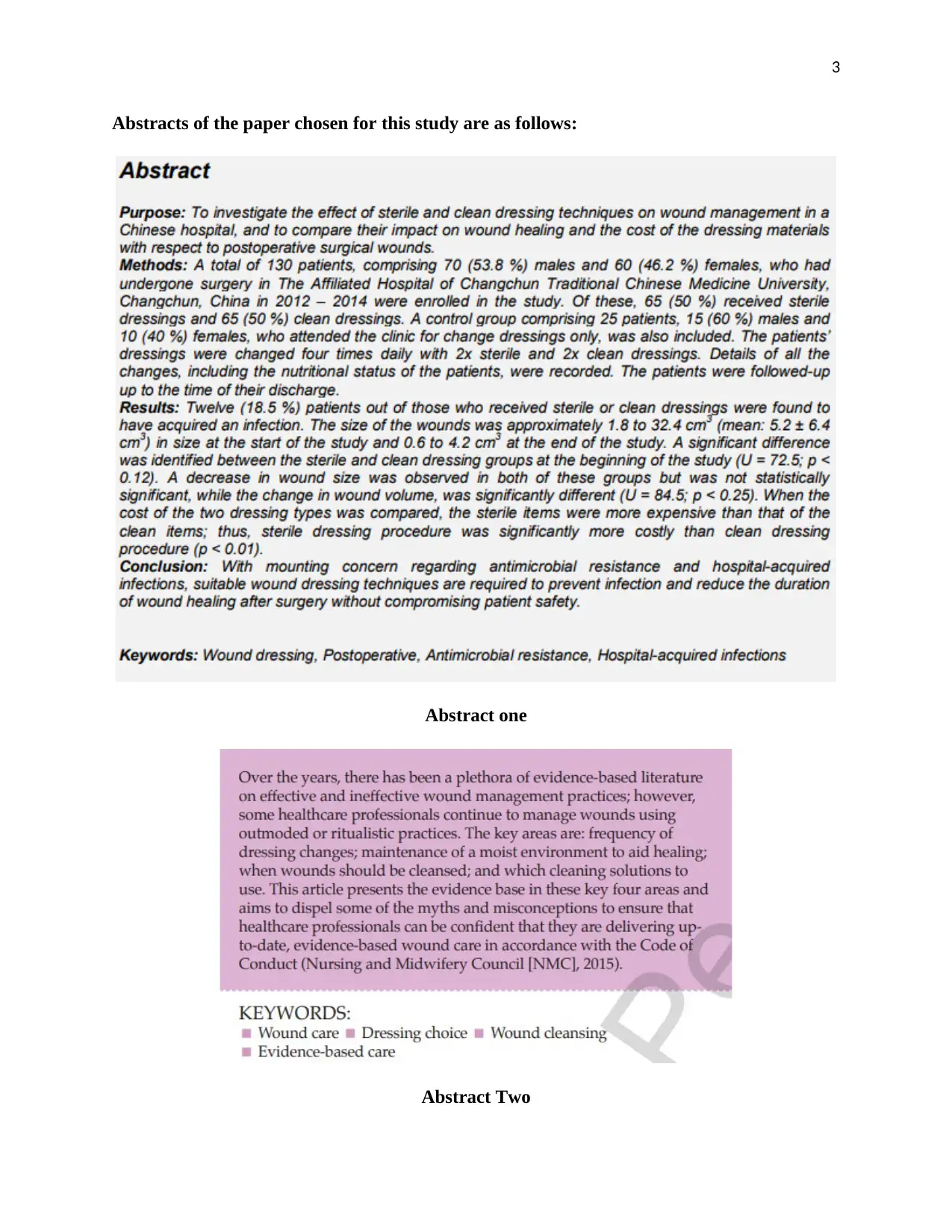
3
Abstracts of the paper chosen for this study are as follows:
Abstract one
Abstract Two
Abstracts of the paper chosen for this study are as follows:
Abstract one
Abstract Two
Paraphrase This Document
Need a fresh take? Get an instant paraphrase of this document with our AI Paraphraser
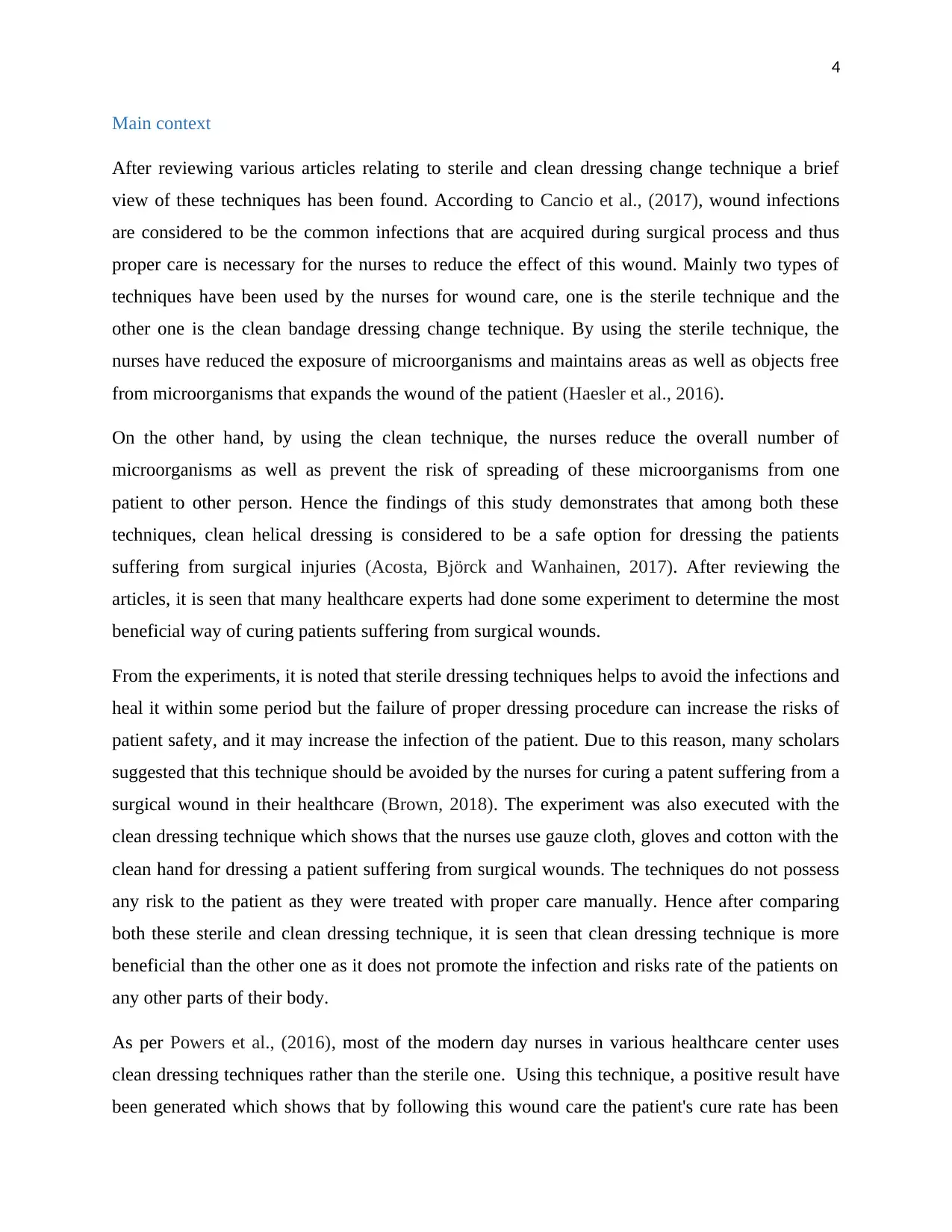
4
Main context
After reviewing various articles relating to sterile and clean dressing change technique a brief
view of these techniques has been found. According to Cancio et al., (2017), wound infections
are considered to be the common infections that are acquired during surgical process and thus
proper care is necessary for the nurses to reduce the effect of this wound. Mainly two types of
techniques have been used by the nurses for wound care, one is the sterile technique and the
other one is the clean bandage dressing change technique. By using the sterile technique, the
nurses have reduced the exposure of microorganisms and maintains areas as well as objects free
from microorganisms that expands the wound of the patient (Haesler et al., 2016).
On the other hand, by using the clean technique, the nurses reduce the overall number of
microorganisms as well as prevent the risk of spreading of these microorganisms from one
patient to other person. Hence the findings of this study demonstrates that among both these
techniques, clean helical dressing is considered to be a safe option for dressing the patients
suffering from surgical injuries (Acosta, Björck and Wanhainen, 2017). After reviewing the
articles, it is seen that many healthcare experts had done some experiment to determine the most
beneficial way of curing patients suffering from surgical wounds.
From the experiments, it is noted that sterile dressing techniques helps to avoid the infections and
heal it within some period but the failure of proper dressing procedure can increase the risks of
patient safety, and it may increase the infection of the patient. Due to this reason, many scholars
suggested that this technique should be avoided by the nurses for curing a patent suffering from a
surgical wound in their healthcare (Brown, 2018). The experiment was also executed with the
clean dressing technique which shows that the nurses use gauze cloth, gloves and cotton with the
clean hand for dressing a patient suffering from surgical wounds. The techniques do not possess
any risk to the patient as they were treated with proper care manually. Hence after comparing
both these sterile and clean dressing technique, it is seen that clean dressing technique is more
beneficial than the other one as it does not promote the infection and risks rate of the patients on
any other parts of their body.
As per Powers et al., (2016), most of the modern day nurses in various healthcare center uses
clean dressing techniques rather than the sterile one. Using this technique, a positive result have
been generated which shows that by following this wound care the patient's cure rate has been
Main context
After reviewing various articles relating to sterile and clean dressing change technique a brief
view of these techniques has been found. According to Cancio et al., (2017), wound infections
are considered to be the common infections that are acquired during surgical process and thus
proper care is necessary for the nurses to reduce the effect of this wound. Mainly two types of
techniques have been used by the nurses for wound care, one is the sterile technique and the
other one is the clean bandage dressing change technique. By using the sterile technique, the
nurses have reduced the exposure of microorganisms and maintains areas as well as objects free
from microorganisms that expands the wound of the patient (Haesler et al., 2016).
On the other hand, by using the clean technique, the nurses reduce the overall number of
microorganisms as well as prevent the risk of spreading of these microorganisms from one
patient to other person. Hence the findings of this study demonstrates that among both these
techniques, clean helical dressing is considered to be a safe option for dressing the patients
suffering from surgical injuries (Acosta, Björck and Wanhainen, 2017). After reviewing the
articles, it is seen that many healthcare experts had done some experiment to determine the most
beneficial way of curing patients suffering from surgical wounds.
From the experiments, it is noted that sterile dressing techniques helps to avoid the infections and
heal it within some period but the failure of proper dressing procedure can increase the risks of
patient safety, and it may increase the infection of the patient. Due to this reason, many scholars
suggested that this technique should be avoided by the nurses for curing a patent suffering from a
surgical wound in their healthcare (Brown, 2018). The experiment was also executed with the
clean dressing technique which shows that the nurses use gauze cloth, gloves and cotton with the
clean hand for dressing a patient suffering from surgical wounds. The techniques do not possess
any risk to the patient as they were treated with proper care manually. Hence after comparing
both these sterile and clean dressing technique, it is seen that clean dressing technique is more
beneficial than the other one as it does not promote the infection and risks rate of the patients on
any other parts of their body.
As per Powers et al., (2016), most of the modern day nurses in various healthcare center uses
clean dressing techniques rather than the sterile one. Using this technique, a positive result have
been generated which shows that by following this wound care the patient's cure rate has been
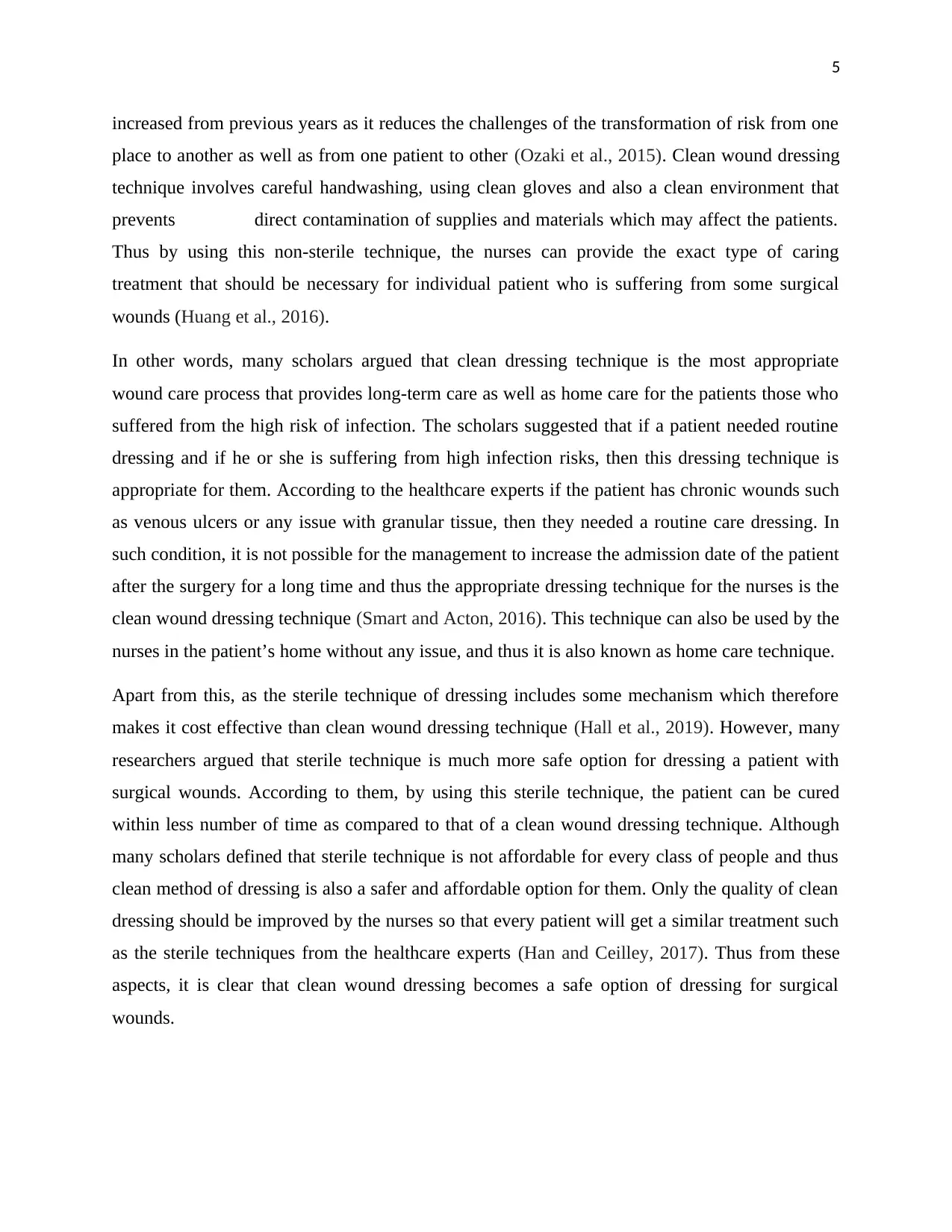
5
increased from previous years as it reduces the challenges of the transformation of risk from one
place to another as well as from one patient to other (Ozaki et al., 2015). Clean wound dressing
technique involves careful handwashing, using clean gloves and also a clean environment that
prevents direct contamination of supplies and materials which may affect the patients.
Thus by using this non-sterile technique, the nurses can provide the exact type of caring
treatment that should be necessary for individual patient who is suffering from some surgical
wounds (Huang et al., 2016).
In other words, many scholars argued that clean dressing technique is the most appropriate
wound care process that provides long-term care as well as home care for the patients those who
suffered from the high risk of infection. The scholars suggested that if a patient needed routine
dressing and if he or she is suffering from high infection risks, then this dressing technique is
appropriate for them. According to the healthcare experts if the patient has chronic wounds such
as venous ulcers or any issue with granular tissue, then they needed a routine care dressing. In
such condition, it is not possible for the management to increase the admission date of the patient
after the surgery for a long time and thus the appropriate dressing technique for the nurses is the
clean wound dressing technique (Smart and Acton, 2016). This technique can also be used by the
nurses in the patient’s home without any issue, and thus it is also known as home care technique.
Apart from this, as the sterile technique of dressing includes some mechanism which therefore
makes it cost effective than clean wound dressing technique (Hall et al., 2019). However, many
researchers argued that sterile technique is much more safe option for dressing a patient with
surgical wounds. According to them, by using this sterile technique, the patient can be cured
within less number of time as compared to that of a clean wound dressing technique. Although
many scholars defined that sterile technique is not affordable for every class of people and thus
clean method of dressing is also a safer and affordable option for them. Only the quality of clean
dressing should be improved by the nurses so that every patient will get a similar treatment such
as the sterile techniques from the healthcare experts (Han and Ceilley, 2017). Thus from these
aspects, it is clear that clean wound dressing becomes a safe option of dressing for surgical
wounds.
increased from previous years as it reduces the challenges of the transformation of risk from one
place to another as well as from one patient to other (Ozaki et al., 2015). Clean wound dressing
technique involves careful handwashing, using clean gloves and also a clean environment that
prevents direct contamination of supplies and materials which may affect the patients.
Thus by using this non-sterile technique, the nurses can provide the exact type of caring
treatment that should be necessary for individual patient who is suffering from some surgical
wounds (Huang et al., 2016).
In other words, many scholars argued that clean dressing technique is the most appropriate
wound care process that provides long-term care as well as home care for the patients those who
suffered from the high risk of infection. The scholars suggested that if a patient needed routine
dressing and if he or she is suffering from high infection risks, then this dressing technique is
appropriate for them. According to the healthcare experts if the patient has chronic wounds such
as venous ulcers or any issue with granular tissue, then they needed a routine care dressing. In
such condition, it is not possible for the management to increase the admission date of the patient
after the surgery for a long time and thus the appropriate dressing technique for the nurses is the
clean wound dressing technique (Smart and Acton, 2016). This technique can also be used by the
nurses in the patient’s home without any issue, and thus it is also known as home care technique.
Apart from this, as the sterile technique of dressing includes some mechanism which therefore
makes it cost effective than clean wound dressing technique (Hall et al., 2019). However, many
researchers argued that sterile technique is much more safe option for dressing a patient with
surgical wounds. According to them, by using this sterile technique, the patient can be cured
within less number of time as compared to that of a clean wound dressing technique. Although
many scholars defined that sterile technique is not affordable for every class of people and thus
clean method of dressing is also a safer and affordable option for them. Only the quality of clean
dressing should be improved by the nurses so that every patient will get a similar treatment such
as the sterile techniques from the healthcare experts (Han and Ceilley, 2017). Thus from these
aspects, it is clear that clean wound dressing becomes a safe option of dressing for surgical
wounds.
⊘ This is a preview!⊘
Do you want full access?
Subscribe today to unlock all pages.

Trusted by 1+ million students worldwide
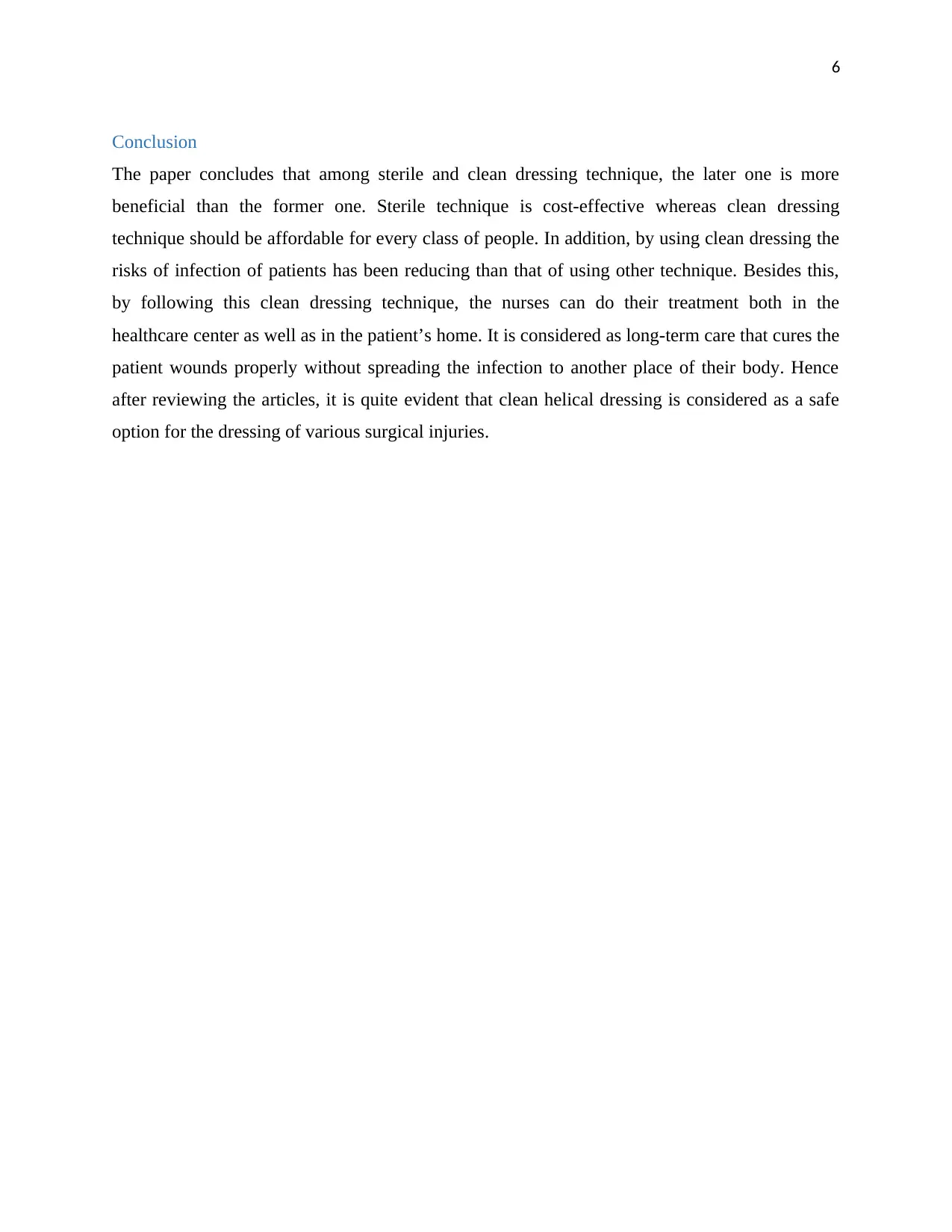
6
Conclusion
The paper concludes that among sterile and clean dressing technique, the later one is more
beneficial than the former one. Sterile technique is cost-effective whereas clean dressing
technique should be affordable for every class of people. In addition, by using clean dressing the
risks of infection of patients has been reducing than that of using other technique. Besides this,
by following this clean dressing technique, the nurses can do their treatment both in the
healthcare center as well as in the patient’s home. It is considered as long-term care that cures the
patient wounds properly without spreading the infection to another place of their body. Hence
after reviewing the articles, it is quite evident that clean helical dressing is considered as a safe
option for the dressing of various surgical injuries.
Conclusion
The paper concludes that among sterile and clean dressing technique, the later one is more
beneficial than the former one. Sterile technique is cost-effective whereas clean dressing
technique should be affordable for every class of people. In addition, by using clean dressing the
risks of infection of patients has been reducing than that of using other technique. Besides this,
by following this clean dressing technique, the nurses can do their treatment both in the
healthcare center as well as in the patient’s home. It is considered as long-term care that cures the
patient wounds properly without spreading the infection to another place of their body. Hence
after reviewing the articles, it is quite evident that clean helical dressing is considered as a safe
option for the dressing of various surgical injuries.
Paraphrase This Document
Need a fresh take? Get an instant paraphrase of this document with our AI Paraphraser
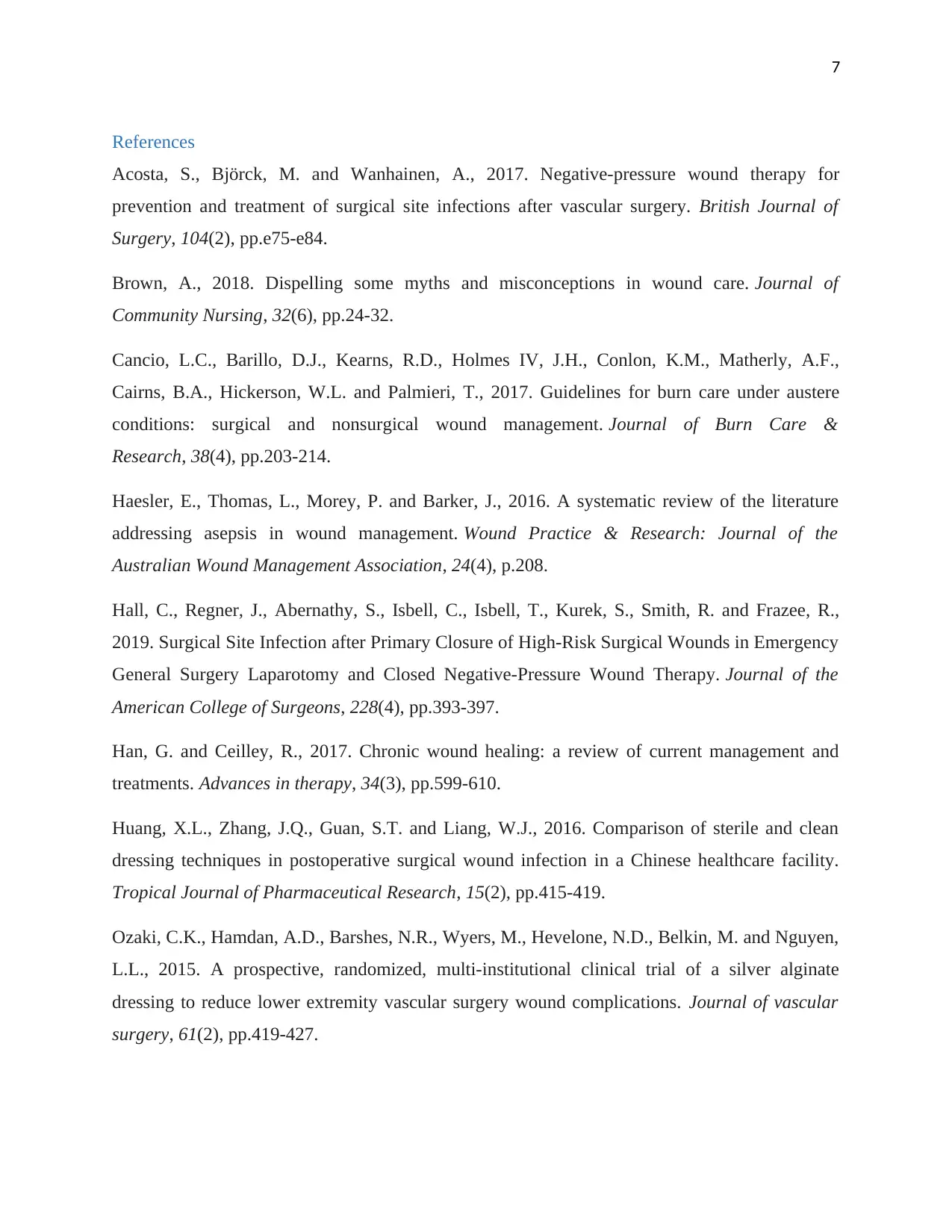
7
References
Acosta, S., Björck, M. and Wanhainen, A., 2017. Negative‐pressure wound therapy for
prevention and treatment of surgical site infections after vascular surgery. British Journal of
Surgery, 104(2), pp.e75-e84.
Brown, A., 2018. Dispelling some myths and misconceptions in wound care. Journal of
Community Nursing, 32(6), pp.24-32.
Cancio, L.C., Barillo, D.J., Kearns, R.D., Holmes IV, J.H., Conlon, K.M., Matherly, A.F.,
Cairns, B.A., Hickerson, W.L. and Palmieri, T., 2017. Guidelines for burn care under austere
conditions: surgical and nonsurgical wound management. Journal of Burn Care &
Research, 38(4), pp.203-214.
Haesler, E., Thomas, L., Morey, P. and Barker, J., 2016. A systematic review of the literature
addressing asepsis in wound management. Wound Practice & Research: Journal of the
Australian Wound Management Association, 24(4), p.208.
Hall, C., Regner, J., Abernathy, S., Isbell, C., Isbell, T., Kurek, S., Smith, R. and Frazee, R.,
2019. Surgical Site Infection after Primary Closure of High-Risk Surgical Wounds in Emergency
General Surgery Laparotomy and Closed Negative-Pressure Wound Therapy. Journal of the
American College of Surgeons, 228(4), pp.393-397.
Han, G. and Ceilley, R., 2017. Chronic wound healing: a review of current management and
treatments. Advances in therapy, 34(3), pp.599-610.
Huang, X.L., Zhang, J.Q., Guan, S.T. and Liang, W.J., 2016. Comparison of sterile and clean
dressing techniques in postoperative surgical wound infection in a Chinese healthcare facility.
Tropical Journal of Pharmaceutical Research, 15(2), pp.415-419.
Ozaki, C.K., Hamdan, A.D., Barshes, N.R., Wyers, M., Hevelone, N.D., Belkin, M. and Nguyen,
L.L., 2015. A prospective, randomized, multi-institutional clinical trial of a silver alginate
dressing to reduce lower extremity vascular surgery wound complications. Journal of vascular
surgery, 61(2), pp.419-427.
References
Acosta, S., Björck, M. and Wanhainen, A., 2017. Negative‐pressure wound therapy for
prevention and treatment of surgical site infections after vascular surgery. British Journal of
Surgery, 104(2), pp.e75-e84.
Brown, A., 2018. Dispelling some myths and misconceptions in wound care. Journal of
Community Nursing, 32(6), pp.24-32.
Cancio, L.C., Barillo, D.J., Kearns, R.D., Holmes IV, J.H., Conlon, K.M., Matherly, A.F.,
Cairns, B.A., Hickerson, W.L. and Palmieri, T., 2017. Guidelines for burn care under austere
conditions: surgical and nonsurgical wound management. Journal of Burn Care &
Research, 38(4), pp.203-214.
Haesler, E., Thomas, L., Morey, P. and Barker, J., 2016. A systematic review of the literature
addressing asepsis in wound management. Wound Practice & Research: Journal of the
Australian Wound Management Association, 24(4), p.208.
Hall, C., Regner, J., Abernathy, S., Isbell, C., Isbell, T., Kurek, S., Smith, R. and Frazee, R.,
2019. Surgical Site Infection after Primary Closure of High-Risk Surgical Wounds in Emergency
General Surgery Laparotomy and Closed Negative-Pressure Wound Therapy. Journal of the
American College of Surgeons, 228(4), pp.393-397.
Han, G. and Ceilley, R., 2017. Chronic wound healing: a review of current management and
treatments. Advances in therapy, 34(3), pp.599-610.
Huang, X.L., Zhang, J.Q., Guan, S.T. and Liang, W.J., 2016. Comparison of sterile and clean
dressing techniques in postoperative surgical wound infection in a Chinese healthcare facility.
Tropical Journal of Pharmaceutical Research, 15(2), pp.415-419.
Ozaki, C.K., Hamdan, A.D., Barshes, N.R., Wyers, M., Hevelone, N.D., Belkin, M. and Nguyen,
L.L., 2015. A prospective, randomized, multi-institutional clinical trial of a silver alginate
dressing to reduce lower extremity vascular surgery wound complications. Journal of vascular
surgery, 61(2), pp.419-427.
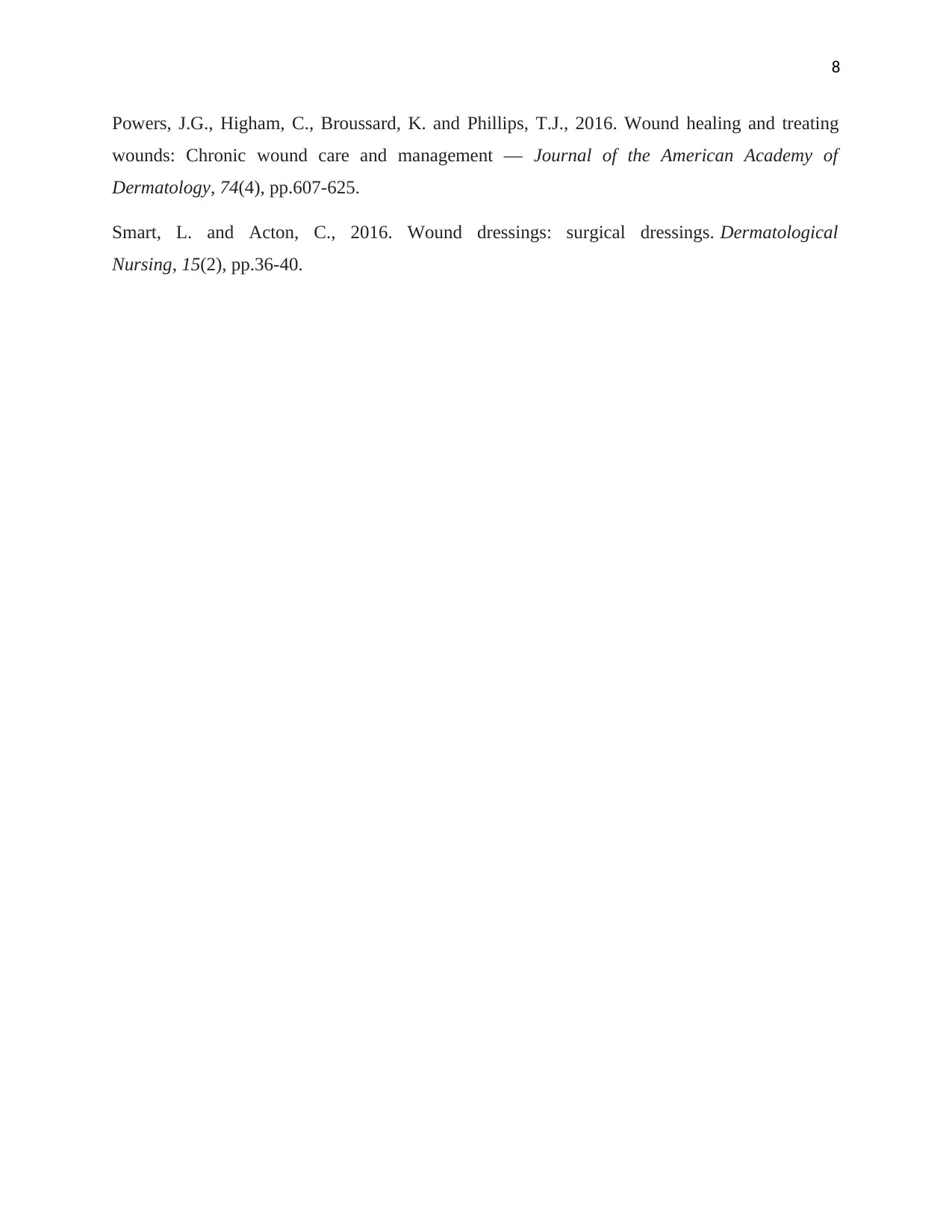
8
Powers, J.G., Higham, C., Broussard, K. and Phillips, T.J., 2016. Wound healing and treating
wounds: Chronic wound care and management — Journal of the American Academy of
Dermatology, 74(4), pp.607-625.
Smart, L. and Acton, C., 2016. Wound dressings: surgical dressings. Dermatological
Nursing, 15(2), pp.36-40.
Powers, J.G., Higham, C., Broussard, K. and Phillips, T.J., 2016. Wound healing and treating
wounds: Chronic wound care and management — Journal of the American Academy of
Dermatology, 74(4), pp.607-625.
Smart, L. and Acton, C., 2016. Wound dressings: surgical dressings. Dermatological
Nursing, 15(2), pp.36-40.
⊘ This is a preview!⊘
Do you want full access?
Subscribe today to unlock all pages.

Trusted by 1+ million students worldwide
1 out of 9
Related Documents
Your All-in-One AI-Powered Toolkit for Academic Success.
+13062052269
info@desklib.com
Available 24*7 on WhatsApp / Email
![[object Object]](/_next/static/media/star-bottom.7253800d.svg)
Unlock your academic potential
Copyright © 2020–2025 A2Z Services. All Rights Reserved. Developed and managed by ZUCOL.





